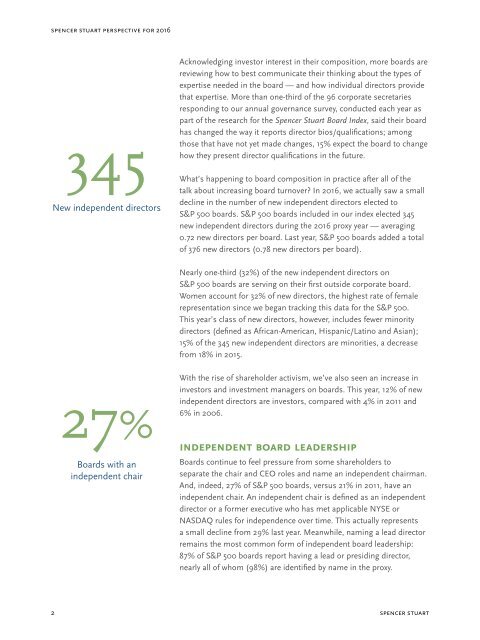Spencer Stuart Board Index
2ipnQXb
2ipnQXb
Create successful ePaper yourself
Turn your PDF publications into a flip-book with our unique Google optimized e-Paper software.
spencer stuart perspective for 2016<br />
345<br />
New independent directors<br />
Acknowledging investor interest in their composition, more boards are<br />
reviewing how to best communicate their thinking about the types of<br />
expertise needed in the board — and how individual directors provide<br />
that expertise. More than one-third of the 96 corporate secretaries<br />
responding to our annual governance survey, conducted each year as<br />
part of the research for the <strong>Spencer</strong> <strong>Stuart</strong> <strong>Board</strong> <strong>Index</strong>, said their board<br />
has changed the way it reports director bios/qualifications; among<br />
those that have not yet made changes, 15% expect the board to change<br />
how they present director qualifications in the future.<br />
What’s happening to board composition in practice after all of the<br />
talk about increasing board turnover? In 2016, we actually saw a small<br />
decline in the number of new independent directors elected to<br />
S&P 500 boards. S&P 500 boards included in our index elected 345<br />
new independent directors during the 2016 proxy year — averaging<br />
0.72 new directors per board. Last year, S&P 500 boards added a total<br />
of 376 new directors (0.78 new directors per board).<br />
Nearly one-third (32%) of the new independent directors on<br />
S&P 500 boards are serving on their first outside corporate board.<br />
Women account for 32% of new directors, the highest rate of female<br />
representation since we began tracking this data for the S&P 500.<br />
This year’s class of new directors, however, includes fewer minority<br />
directors (defined as African-American, Hispanic/Latino and Asian);<br />
15% of the 345 new independent directors are minorities, a decrease<br />
from 18% in 2015.<br />
27%<br />
<strong>Board</strong>s with an<br />
independent chair<br />
With the rise of shareholder activism, we’ve also seen an increase in<br />
investors and investment managers on boards. This year, 12% of new<br />
independent directors are investors, compared with 4% in 2011 and<br />
6% in 2006.<br />
Independent board leadership<br />
<strong>Board</strong>s continue to feel pressure from some shareholders to<br />
separate the chair and CEO roles and name an independent chairman.<br />
And, indeed, 27% of S&P 500 boards, versus 21% in 2011, have an<br />
independent chair. An independent chair is defined as an independent<br />
director or a former executive who has met applicable NYSE or<br />
NASDAQ rules for independence over time. This actually represents<br />
a small decline from 29% last year. Meanwhile, naming a lead director<br />
remains the most common form of independent board leadership:<br />
87% of S&P 500 boards report having a lead or presiding director,<br />
nearly all of whom (98%) are identified by name in the proxy.<br />
2<br />
spencer stuart


